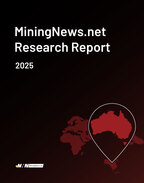This article is 10 years old. Images might not display.
It has applied to the ASX to suspend trading from April 25.
The ASX was investigating how the company was able to list, and the anomalous trading in the weeks after it joined the bourse.
The fledgling junior collected an astonishing six speeding tickets off the back of a share price that soared from 20c at listing in May 2014 to an astounding $8.03 per share, a feat achieved off some middle-of-the-road early stage assets in New South Wales and absolutely no news flow whatsoever.
Soon after listing it apparent that there was something unusual about the company, given its market capitalisation soared towards of $175 million.
The ASX issued six 'please explain' notices, to which former company secretary Nicholas Geddes reliably informed the market that, no, there was no information not in the public domain to explain the trades – in fact there was little information at all – and that the company was cheerfully able to state that it had fully complied with the Listing Rules.
Except that did not appear to have been the case.
Fifth Element never lodged a statement of its top 20 shareholders on listing, and when it finally did lodge an updated list in July 2014 it became clear that the top 20 shareholders were, in fact, the top 13 shareholders, and they owned 100% of the company, with Diamond Peak Overseas holding 48.32%. The top three controlled 95%.
Executive director William Lo paid his own company, EJ Resources, some $86,000 for Fifth Element's four properties for which EJ gained 1.04% of the shares on issue.
Lo is also a director of Diamond Peak, which reportedly paid $200,000 for its 20 million shares prior to the IPO during an earlier seed raising.
On the first day of trade a businessman called Yang Zhang paid $1.4 million for 7.2 million shares, making him the third largest shareholder.
On 29 May he sold 1.49% of his holding for $132,000 and then three weeks later he sold down his 15.945% stake to 11.572% on the market, pocketing $2.8 million in what must be one of the luckiest days of trading in memory.
Although, by July 2014 his holding was apparently missing from the top 20 despite Zhang apparently not having sold any more shares.
With the company's share price inexplicably soaring off just a few trades the ASX finally stepped in and suspended the company from trading, but not to investigate not Fifth Element's unusual trading patterns, but pending a review of its satisfaction of conditions to trade on the bourse.
Fifth Element raised $4.19 million in its oversubscribed IPO, and according to its prospectus intends to spend half of that over the first two years, with $620,000 due in year one for geophysics and overheads and $1.56 million budgeted in year two for some RC and diamond drilling.
It undertook its first major fieldwork, aeromag surveys, in November, and had about $3 million in cash remaining.
The focus of Fifth Element was to discover and assess gold and copper deposits of more than 500,000 ounces of gold or equivalent in under-explored areas of an established mineral province in NSW located on the Molong Volcanic Belt and the Junee-Naromine Volcanic Belt.
The four copper and gold projects consist of four exploration licences cover a total of 706.09 square kilometres including: Fairholme, EL 8026 covering 109sq.km; Pine Hill, EL 8027 covering 160.28sq.km; Trangie, EL 8140 covering 221.16sq.km; and Mendooran, EL 8141 covering 215.65sq.km.
The Fairholme project is located 37km north of Barrick’s Cowal gold mine and just 15km north of porphyry related Cu-Au mineralisation at Clancy Exploration’s Dungarvan and Gateway prospects, first identified by Newcrest in 1996.
The complex is overlain by up to 100m of recent sedimentary cover which has constrained historic exploration activity, however work since 2012 has identified a zone of enhanced magnetics coincident with a gravity low in a setting similar to the Cowal Igneous Complex.
The Pine Hill project is centred on the extreme northern extent of the Cowal Igneous Complex where there has been limited effective historic exploration.
Trangie is located along the north-west trending axis of the 10km wide Narromine Igneous Complex, which is part of the northern section of the productive Junee-Narromine Volcanic Belt where cover has again constrained past exploration, but it may host a 2km shear zone that could represent a northwest extension of the Parkes Shear which hosts the hydrothermal replacement gold deposits of Tomingley and nearby high sulphidation style epithermal deposit at Peak Hill gold mine.
The Mendooran project is centred on a 15km wide concealed northern section of the Molong Volcanic Belt, that has a magnetic and gravity feature that could indicate a large scale feature parallel to and analogous with the geologically significant Lachlan Transverse Feature some 170km to the south.
The company said it was considering post-listing arrangements for its few shareholders.

























